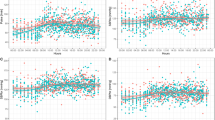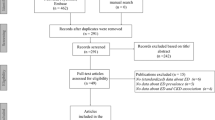Abstract
Sexual dysfunction (SD) is common in men and women with chronic kidney disease (CKD) and is considered as an early marker for cardiovascular (CV) disease. We hypothesized that patients with SD have higher risk for vascular damage of the large arteries, accelerated vascular aging, and consequently higher CV mortality than other end-stage renal disease (ESRD) patients. In this study, the International Index of Erectile Function (IIEF) questionnaire and the Female Sexual Function Index (FSFI) questionnaire were applied in men and women, respectively. Ambulatory blood pressure monitoring (ABPM), arterial stiffness, and ankle-brachial index (ABI) were performed in all patients. Pulse wave velocity (PWV) was significantly slower in non-SD patients (10.5 vs. 8.8 m/s; p < 0.001) with significantly lower number of non-SD patients with PWV > 10 m/s compared to SD patients (p < 0.001). Only 57% of the patients with prior CV event had PWV > 10 m/s. No difference in AIx was observed. Non-SD patients had better values of ABI (0.83 vs. 1.09; p < 0.05) with significantly lower number of non-SD patients with ABI < 0.9 compared to SD patients (p = 0.001) as well as smaller percentage of LVH (57.5% vs. 80.7%; p = 0.01). There were no differences in hemodynamic parameters when patients with SD were divided by sex. Pulse wave velocity was the strongest predictor of lower IIEF and FSFI scores. Mean survival time was longer in non-SD patients than in SD patients (11.6 vs. 10.5 months, p = 0.019). The higher incidence of prior CV events and CV mortality found in SD patients on hemodialysis (HD) is a consequence of accelerated vascular aging. Sexual dysfunction in HD patients should also be considered a marker of subclinical organ damage and future CV events. Our study confirms the predictive role of PWV in HD patients.
This is a preview of subscription content, access via your institution
Access options
Subscribe to this journal
Receive 8 print issues and online access
$259.00 per year
only $32.38 per issue
Buy this article
- Purchase on Springer Link
- Instant access to full article PDF
Prices may be subject to local taxes which are calculated during checkout


Similar content being viewed by others
References
Turk S, Guney I, Altintepe L, Tonbul Z, Yildiz A, Yeksan M. Quality of life in male hemodialysis patients. Role of erectile dysfunction. Nephron Clin Pract. 2004;96:c21–7.
Peng YS, Chiang CK, Kao TW, Hung KY, Lu CS, Chiang SS, et al. Sexual dysfunction in female hemodialysis patients: a multicenter study. Kidney Int. 2005;68:760–5.
Rosas SE, Joffe M, Franklin E, Strom BL, Kotzker W, Brensinger C, et al. Prevalence and determinants of erectile dysfunction in hemodialysis patients. Kidney Int. 2001;59:2259–66.
Seethala S, Hess R, Bossola M, Unruh ML, Weisbord SD. Sexual function in women receiving maintenance dialysis. Hemodial Int. 2010;14:55–60.
Laumann EO, Nicolosi A, Glasser DB, Paik A, Gingell C, Moreira E, Wang T. GSSAB Investigators’ Group. Sexual problems among women and men aged 40–80 y: prevalence and correlates identified in the Global Study of Sexual Attitudes and Behaviors. Int J Impot Res. 2005;17:39–57.
Go AS, Chertow GM, Fan D, McCulloch CE, Hsu CY. Chronic kidney disease and the risks of death, cardiovascular events, and hospitalization. N Engl J Med. 2004;351:1296–305.
Montorsi P, Ravagnani PM, Galli S, Rotatori F, Briganti A, Salonia A, et al. The artery size hypothesis: a macrovascular link between erectile dysfunction and coronary artery disease. Am J Cardiol. 2005;96:19M–23M.
Vlachopoulos CV, Terentes-Printzios DG, Ioakeimidis NK, Aznaouridis KA, Stefanadis CI. Prediction of cardiovascular events and all-cause mortality with erectile dysfunction: a systematic review and meta-analysis of cohort studies. Circ Cardiovasc Qual Outcomes. 2013;6:99–109.
Araujo AB, Hall SA, Ganz P, Chiu GR, Rosen RC, Kupelian V, et al. Does erectile dysfunction contribute to cardiovascular disease risk prediction beyond the Framingham risk score? J Am Coll Cardiol. 2010;55:350–6.
Ponholzer A, Temml C, Obermayr R, Wehrberger C, Madersbacher S. Is erectile dysfunction an indicator for increased risk of coronary heart disease and stroke? Eur Urol. 2005;48:512–8.
Laurent S, Cockcroft J, Van Bortel L, Boutouyrie P, Giannattasio C, Hayoz D, et al. European Network for Non-invasive Investigation of Large Arteries. Expert consensus document on arterial stiffness: methodological issues and clinical applications. Eur Heart J. 2006;27:2588–605.
Vlachopoulos C, Aznaouridis K, Ioakeimidis N, Rokkas K, Tsekoura D, Vasiliadou C, et al. Arterial function and intima-media thickness in hypertensive patients with erectile dysfunction. J Hypertens. 2008;26:1829–36.
Vlachopoulos C, Aznaouridis K, Stefanadis C. Aortic stiffness for cardiovascular risk prediction: just measure it, just do it! J Am Coll Cardiol. 2014;63:647–9.
Mitchell GF, Hwang SJ, Vasan RS, Larson MG, Pencina MJ, Hamburg NM, et al. Arterial stiffness and cardiovascular events: the Framingham Heart Study. Circulation 2010;121:505–11.
Guerin AP, Blacher J, Pannier B, Marchais SJ, Safar ME, London GM. Impact of aortic stiffness attenuation on survival of patients in end-stage renal failure. Circulation 2001;20:987–92.
Blacher J, Guerin AP, Pannier B, Marchais SJ, Safar ME, London GM. Impact of aortic stiffness on survival in end-stage renal disease. Circulation 1999;99:2434–9.
Rosen RC, Cappelleri JC, Gendrano N 3rd. The International Index of Erectile Function (IIEF): a state-of-the-science review. Int J Impot Res. 2002;14:226–44.
Meston CM. Validation of the Female Sexual Function Index (FSFI) in women with female orgasmic disorder and in women with hypoactive sexual desire disorder. J Sex Marital Ther. 2003;29:39–46.
Jatoi NA, Mahmud A, Bennett K, Feely J. Assessment of arterial stiffness in hypertension: comparison of oscillometric (Arteriograph), piezoelectronic (Complior) and tonometric (SphygmoCor) techniques. J Hypertens. 2009;27:2186–91.
ESH/ESC Task Force for the Management of Arterial Hypertension. Practice guidelines for the management of arterial hypertension of the European Society of Hypertension (ESH) and the European Society of Cardiology (ESC): ESH/ESC task force for the management of arterial hypertension. J Hypertens. 2013;31:1925–38.
Devereux RB, Reichek N, Echocardiographic determination of left ventricular mass in man. Anatomic validation of the method. Circulation. 1977;55:613–8.
Carrero JJ, Kyriazis J, Sonmez A, Tzanakis I, Qureshi AR, Stenvinkel P, et al. Prolactin levels, endothelial dysfunction, and the risk of cardiovascular events and mortality in patients with CKD. Clin J Am Soc Nephrol. 2012;7:207–15.
Thompson IM, Tangen CM, Goodman PJ, Probstfield JL, Moinpour CM, Coltman CA. Erectile dysfunction and subsequent cardiovascular disease. JAMA 2005;294:2996–3002.
Batty GD, Li Q, Czernichow S, Neal B, Zoungas S, Huxley R,et al. ADVANCE Collaborative Group. Erectile dysfunction and later cardiovascular disease in men with type 2 diabetes: prospective cohort study based on the ADVANCE (Action in Diabetes and Vascular Disease: Preterax and Diamicron Modified-Release Controlled Evaluation) trial. J Am Coll Cardiol. 2010;56:1908–13.
London GM, Guerin AP, Marchais SJ, Pannier B, Safar ME, Day M, et al. Cardiac and arterial interactions in end-stage renal disease. Kidney Int. 1996;50:600–8.
Briet M, Boutouyrie P, Laurent S, London GM. Arterial stiffness and pulse pressure in CKD and ESRD. Kidney Int. 2012;82:388–400.
Vlachopoulos C, Ioakeimidis N, Aznaouridis K, Terentes-Printzios D, Rokkas K, Aggelis A, et al. Prediction of cardiovascular events with aortic stiffness in patients with erectile dysfunction. Hypertension 2014;64:672–8.
Bolton CH, Downs LG, Victory JG, Dwight JF, Tomson CR, Mackness MI, et al. Endothelial dysfunction in chronic renal failure: roles of lipoprotein oxidation and proinflammatory cytokines. Nephrol Dial Transplant. 2001;16:1189–97.
Navaneethan SD, Vecchio M, Johnson DW, Saglimbene V, Graziano G, Pellegrini F, et al. Prevalence and correlates of self-reported sexual dysfunction in CKD: a meta-analysis of observational studies. Am J Kidney Dis. 2010;56:670–85.
Nassir A. Erectile dysfunction risk factors for patients entering dialysis programme. Andrologia 2010;42:41–7.
Nicolai MPJ, Liem SS, Both S, Pelger RC, Putter H, Schalij MJ, et al. A review of the positive and negative effects of cardiovascular drugs on sexual function: a proposed table for use in clinical practice. Neth Heart J. 2014;22:11–9.
Matsumoto C, Tomiyama H, Yamada J, Yoshida M, Shiina K, Yamashina A. Brachial-ankle pulse wave velocity as a marker of subclinical organ damage in middle-aged patients with hypertension. J Cardiol. 2008;51:163–70.
Wachtell K, Okin PM, Olsen MH, Dahlöf B, Devereux RB, Ibsen H, et al. Regression of electrocardiographic left ventricular hypertrophy during antihypertensive therapy and reduction in sudden cardiac death: the LIFE study. Circulation. 2007;116:700–5
Nilsson PM, Boutouyrie P, Laurent S. Vascular aging: a tale of EVA and ADAM in cardiovascular risk assessment and prevention. Hypertension 2009;54:3–10.
Author information
Authors and Affiliations
Corresponding author
Ethics declarations
Conflict of interest
The authors declare that they have no conflict of interest.
Rights and permissions
About this article
Cite this article
Premužić, V., Jelaković, B. Sexual dysfunction as a determinant of cardiovascular outcome in patients undergoing chronic hemodialysis. Int J Impot Res 30, 14–20 (2018). https://doi.org/10.1038/s41443-017-0001-7
Received:
Revised:
Accepted:
Published:
Issue Date:
DOI: https://doi.org/10.1038/s41443-017-0001-7
This article is cited by
-
Male sexual dysfunction in patients with chronic kidney disease: a cross-sectional study
Scientific Reports (2024)
-
Female Sexual Dysfunction as a Warning Sign of Chronic Disease Development
Current Sexual Health Reports (2019)



